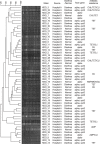Prevalence, toxin gene profile, antibiotic resistance, and molecular characterization of Clostridium perfringens from diarrheic and non-diarrheic dogs in Korea
- PMID: 29486533
- PMCID: PMC5974518
- DOI: 10.4142/jvs.2018.19.3.368
Prevalence, toxin gene profile, antibiotic resistance, and molecular characterization of Clostridium perfringens from diarrheic and non-diarrheic dogs in Korea
Abstract
Clostridium perfringens causes diarrhea and other diseases in animals and humans. We investigated the prevalence, toxin gene profiles, and antibiotic resistance of C. perfringens isolated from diarrheic dogs (DD) and non-diarrheic dogs (ND) in two animal hospitals in Seoul, Korea. Fecal samples were collected from clinically DD (n = 49) and ND (n = 34). C. perfringens was isolated from 31 of 49 DD (63.3%) and 21 of 34 ND dogs (61.8%). All C. perfringens strains were positive for the α toxin gene, but not for the β, ε, or ι toxin genes; therefore, all strains were identified as type A C. perfringens. All isolates were cpe-negative, whereas the β2 toxin gene was identified in 83.9% and 61.9% of isolates from DD and ND, respectively. Most isolates were susceptible to ampicillin (94%), chloramphenicol (92%), metronidazole (100%), moxifloxacin (96%), and imipenem (100%). However, 25.0% and 21.2% of isolates were resistant to tetracycline and clindamycin, respectively. Molecular subtyping of the isolated strains was performed by using pulsed-field gel electrophoresis. Fifty-two isolates were classified into 48 pulsotypes based on more than 90% similarity of banding patterns. No notable differences were observed among the isolates from DD and ND.
Keywords: Clostridium perfringens; bacterial toxins; dogs; drug resistance; pulsed-field gel electrophoresis.
Conflict of interest statement
Figures
Similar articles
-
Prevalence and toxin gene profiles of Clostridium perfringens in diarrheic dogs and cats in Korea: a retrospective analysis.J Vet Sci. 2025 Jul;26(4):e52. doi: 10.4142/jvs.24361. J Vet Sci. 2025. PMID: 40765232 Free PMC article.
-
Detection and characterization of Clostridium perfringens in the feces of healthy and diarrheic dogs.Can J Vet Res. 2012 Jul;76(3):161-5. Can J Vet Res. 2012. PMID: 23277693 Free PMC article.
-
Genotypic and phenotypic characterization of Clostridium perfringens and Clostridium difficile in diarrheic and healthy dogs.J Vet Intern Med. 2002 Sep-Oct;16(5):533-40. doi: 10.1892/0891-6640(2002)016<0533:gapcop>2.3.co;2. J Vet Intern Med. 2002. PMID: 12322702
-
Prevalence, molecular characterization, and antimicrobial resistance profile of Clostridium perfringens from India: A scoping review.Anaerobe. 2022 Oct;77:102639. doi: 10.1016/j.anaerobe.2022.102639. Epub 2022 Sep 13. Anaerobe. 2022. PMID: 36108893
-
NetF-producing Clostridium perfringens and its associated diseases in dogs and foals.J Vet Diagn Invest. 2020 Mar;32(2):230-238. doi: 10.1177/1040638720904714. Epub 2020 Feb 21. J Vet Diagn Invest. 2020. PMID: 32081091 Free PMC article. Review.
Cited by
-
Metronidazole treatment of acute diarrhea in dogs: A randomized double blinded placebo-controlled clinical trial.J Vet Intern Med. 2020 Jan;34(1):98-104. doi: 10.1111/jvim.15664. Epub 2019 Nov 19. J Vet Intern Med. 2020. PMID: 31742807 Free PMC article.
-
GSAMDA: a computational model for predicting potential microbe-drug associations based on graph attention network and sparse autoencoder.BMC Bioinformatics. 2022 Nov 18;23(1):492. doi: 10.1186/s12859-022-05053-7. BMC Bioinformatics. 2022. PMID: 36401174 Free PMC article.
-
Clostridium perfringens Associated with Foodborne Infections of Animal Origins: Insights into Prevalence, Antimicrobial Resistance, Toxin Genes Profiles, and Toxinotypes.Biology (Basel). 2022 Apr 1;11(4):551. doi: 10.3390/biology11040551. Biology (Basel). 2022. PMID: 35453750 Free PMC article.
-
Characterization of a novel bacteriophage φCJ22 and its prophylactic and inhibitory effects on necrotic enteritis and Clostridium perfringens in broilers.Poult Sci. 2021 Jan;100(1):302-313. doi: 10.1016/j.psj.2020.10.019. Epub 2020 Oct 14. Poult Sci. 2021. PMID: 33357694 Free PMC article.
-
Prevalence and toxin gene profiles of Clostridium perfringens in diarrheic dogs and cats in Korea: a retrospective analysis.J Vet Sci. 2025 Jul;26(4):e52. doi: 10.4142/jvs.24361. J Vet Sci. 2025. PMID: 40765232 Free PMC article.
References
-
- Baums CG, Schotte U, Amtsberg G, Goethe R. Diagnostic multiplex PCR for toxin genotyping of Clostridium perfringens isolates. Vet Microbiol. 2004;100:11–16. - PubMed
-
- Berset-Istratescu CM, Glardon OJ, Magouras I, Frey CF, Gobeli S, Burgener IA. Follow-up of 100 dogs with acute diarrhoea in a primary care practice. Vet J. 2014;199:188–190. - PubMed
-
- Bueschel DM, Jost BH, Billington SJ, Trinh HT, Songer JG. Prevalence of cpb2, encoding beta2 toxin, in Clostridium perfringens field isolates: correlation of genotype with phenotype. Vet Microbiol. 2003;94:121–129. - PubMed
-
- Chon JW, Hyeon JY, Park JH, Song KY, Kim JH, Seo KH. Improvement of mannitol-yolk-polymyxin B agar by supplementing with trimethoprim for quantitative detection of Bacillus cereus in foods. J Food Prot. 2012;75:1342–1345. - PubMed
-
- Chon JW, Park JS, Hyeon JY, Park C, Song KY, Hong KW, Hwang IG, Kwak HS, Seo KH. Development of real-time PCR for the detection of Clostridium perfringens in meats and vegetables. J Microbiol Biotechnol. 2012;22:530–534. - PubMed
MeSH terms
Substances
LinkOut - more resources
Full Text Sources
Other Literature Sources
Medical
Molecular Biology Databases
Research Materials
Miscellaneous


